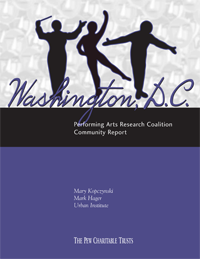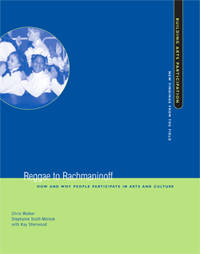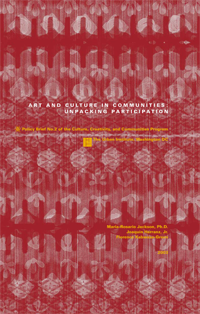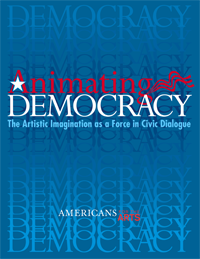Cultural Policy
On May 12th, more than 60 artists and creative organizers engaged in civic participation, community development, education, social justice activism, and philanthropy came together for a White House briefing on Art, Community, Social Justice, National Recovery.
Read More...2004, 58 pages, Performing Arts Research Coalition, 1156 15th Street NW, Suite 810, Washington, D.C., 20005
Download:
Read More...2010, 72 pages, The Urban Institute, 2100 M Street NW, Washington, D.C., 20037, (202) 833-7200 http://www.urban.org
Download:
![]() Reggae to Rachmaninoff (397Kb)
Reggae to Rachmaninoff (397Kb)
2010, 12 pages, The Urban Institute, 2100 M Street NW, Washington, D.C., 20037, (202) 833-7200 http://www.urban.org
Download:
Read More...2010, 138 pages, Americans for the Arts, 1000 Vermont Ave. NW, Washington, D.C., 20005, (202) 371-2830 http://www.artsusa.org
Download:
Read More...This handbook describes how partnerships between local cultural agencies, schools, businesses, and other sectors of the community can make a positive impact on arts education. Learn how 11 communities built their local partnerships, and how you can adapt similar programs to your community.
40pp, saddle-stitched paper (1995, Americans for the Arts' Institute for Community Development and the Arts)
Available online from Americans for the Arts
Read More...Ralph Smith, the 2007 Conference Chairman, issued a challenge in his welcome message – “that all who attend will leave with renewed energy, capacity and resolve to make a positive contribution toward meeting the challenges of our time.”
Read More...This brief presents research findings as well as policy recommendations arising from a study of the No Child Left Behind Act and its implications for immigrant children and English language learners (ELLs). Analyses are based on nationally-representative data from the Schools and Staffing Survey and detailed case studies of selected elementary schools and school districts serving high concentrations of ELL students. Results reveal an extraordinary degree of concentration of ELL students in a few schools that tend to be large, urban and serve a predominantly minority student population.
Read More...Native America at the new Millennium is a Ford Foundation-funded collaboration by the Harvard Project, Native Nations Institute, and First Nations Development Institute that serves as a primer on contemporary American Indian affairs. NANM addresses topics as wide-ranging as tribal government, non-profit organizations, political activism, economic development, housing, welfare, health, arts, and media.
Read More...More than 100 sources were interviewed, consulted, or literature reviewed for information for this study on Native American Philanthropy.
"Native communities have always practiced various forms of giving, from rituals and religious ceremonies to auctions and art fairs." Read on as this study explains how Native American communities have always been involved with, and are increasing their visibility in philanthropy.
Download pdf from Native Americans in Philanthropy.
Read More...



